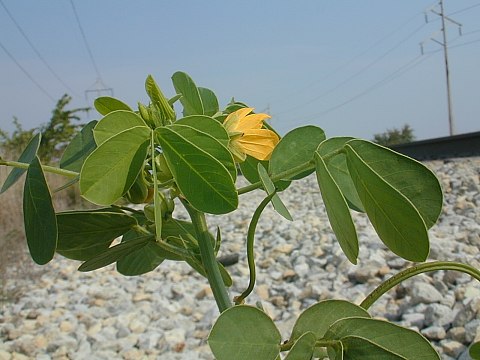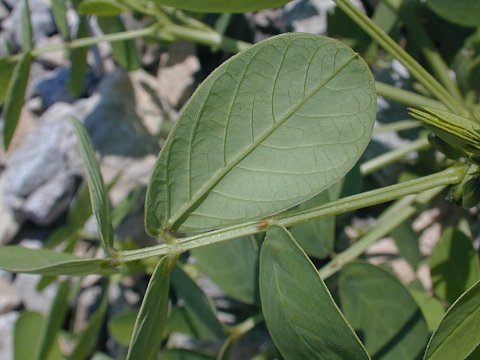Description: This annual plant is 1-2½' tall, branching occasionally. The stems are light green and somewhat ridged. The lower stems often sprawl along the ground in open areas, otherwise this plant is erect. The compound leaves alternate along the stems. They are evenly pinnate, usually with 3 pairs of leaflets, and have long leaf stems (primary petioles). The obovate leaflets are individually 1½" long and 1" across. They are devoid of hairs and pale green on their undersides. There is an extra-floral nectary close to the lowest pair of leaflets on the upper side of each compound leaf. This nectary resembles a small brown spike. The foliage has a slightly rank odor.

One or two flowers
develop from the upper axils of the compound leaves. These flowers have
pedicels about 1" long and tend to nod slightly downward. They are
about 1" across, and consist of 5 rounded yellow petals and 10 stamens;
the petals are often slightly unequal in size. The flowers are
subtended by a light green calyx that is divided into 5 folded sepals;
these sepals are shorter than the petals and hairless. In Illinois, the
blooming period occurs from late summer through the fall, and lasts
about 1-2 months. There is no floral scent. A long seedpod develops
from each flower that is 4-6" long, but only 1/3" across. This seedpod
curves downward and resembles a sickle in its overall shape. The root
system consists of taproot. This plant spreads by reseeding itself.
Cultivation:
The preference is full sun and moist to slightly dry conditions. This
plant tolerates different kinds of soil, from fertile loam to gravelly
soil; in fact, it often thrives in railroad ballast. Drought tolerance
is good, and the foliage is rarely bothered by foliar disease. It is
somewhat slow to develop for an annual plant, and tends to bloom late
in the year in Illinois.

Range &
Habitat:
Sicklepod has been reported from only a few counties in southern
Illinois and in the Chicago area; it has been observed recently along
a railroad track in Champaign County, where it is probably
adventive from the south (see Distribution
Map). This is a rare plant in Illinois, although it is more
common in many south-central and southeastern states of the US; it also
occurs in the American tropics. In southern Illinois, Sicklepod may be
native, while elsewhere in the state it is definitely adventive from
the south. Habitat information is scanty, but it
has been observed in moist meadows along rivers, open areas along
railroads, and in waste areas. Areas with a history of disturbance are
preferred.
Faunal Associations:
The extra-floral nectaries attract ants primarily; they may also
attract some wasps, flies, or small bees. The pollen of the flowers
attract long-tongued bees, such as bumblebees, Miner bees, and large
Leaf-Cutting bees. The caterpillars of several species of Sulfur
butterflies are known to feed on the foliage of Cassia spp.,
including Eurema lisa (Little Sulfur), Eurema
nicippe (Sleepy Orange), and Phoebis sennae cubule
(Cloudless Sulfur). Some upland gamebirds occasionally eat the seeds of
Senna spp., especially the Bobwhite and Greater
Prairie Chicken. Mammalian herbivores are unlikely to utilize this
plant as a food source to any significant extent because of the
unpleasant taste and toxic nature of the foliage, which has been found
capable of poisoning livestock.

Photographic
Location:
Photographs were taken along a railroad in Savoy, Illinois.
Comments:
This rare plant has attractive foliage, but blooms sparingly. Sicklepod
resembles Senna marilandica
(Maryland Senna) and Senna hebecarpa (Wild Senna)
somewhat in appearance, but it is a shorter annual plant that has 1)
fewer leaflets per compound leaf, 2) leaflets with a more obovate
shape, and 3) seedpods that are more curved and slender. In
the past, Sicklepod was assigned to the Bean family (Fabaceae),
rather than the Caesalpinia family.